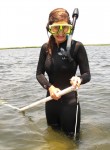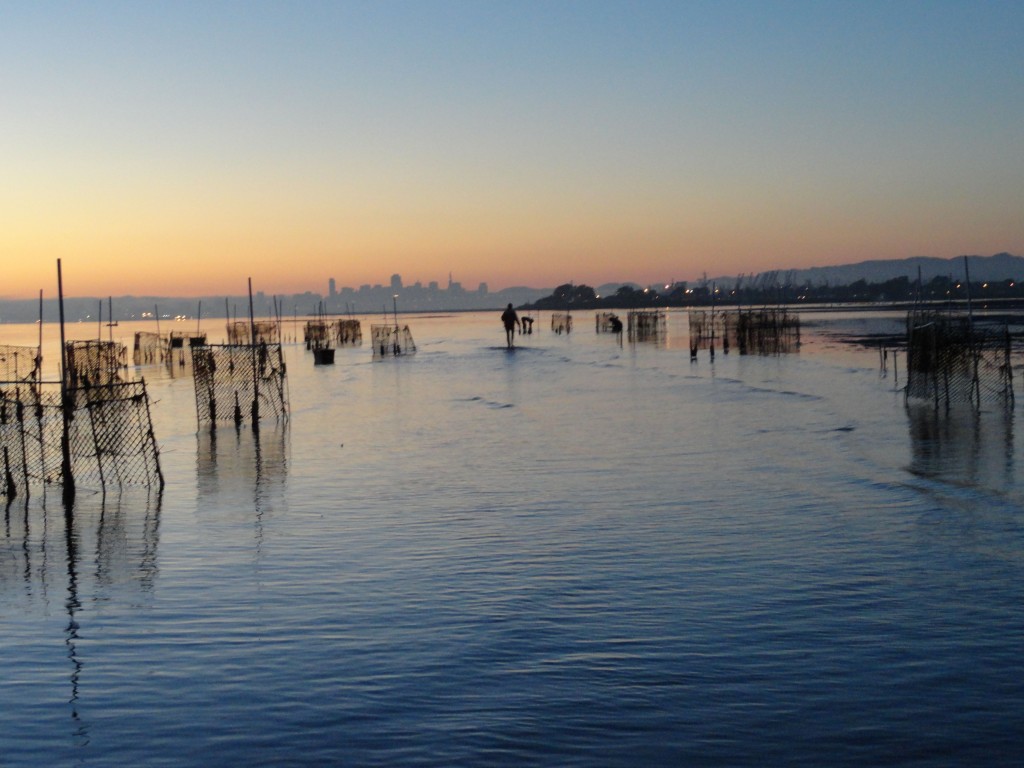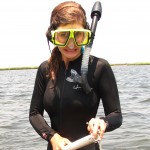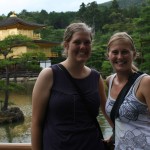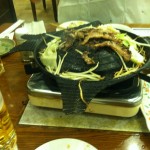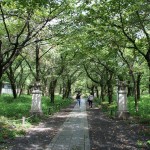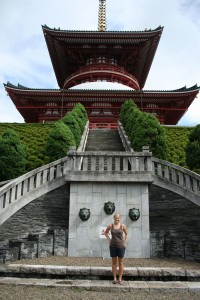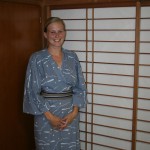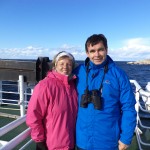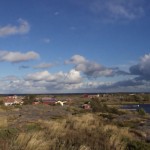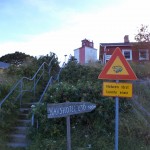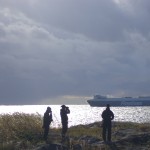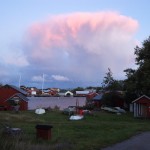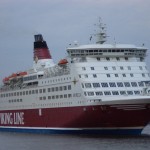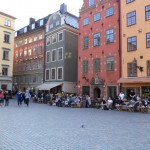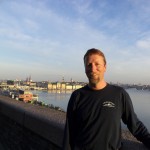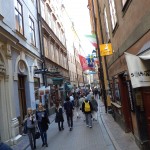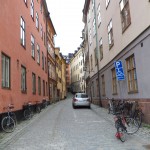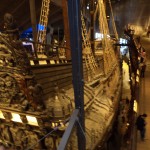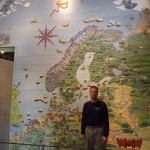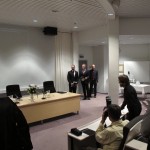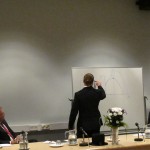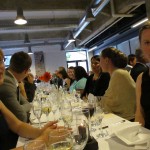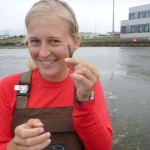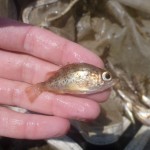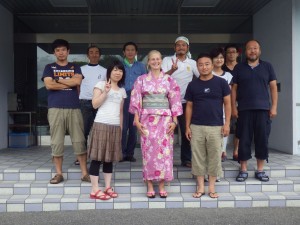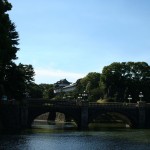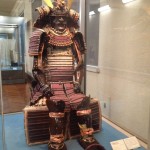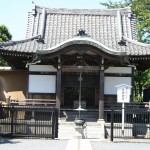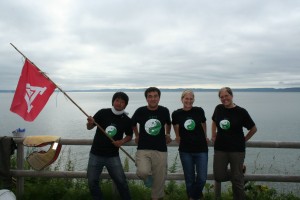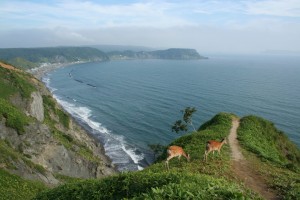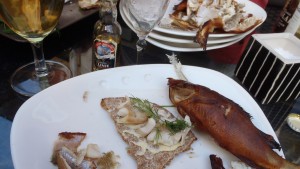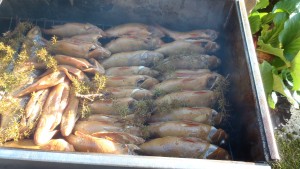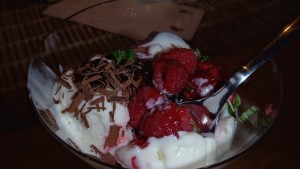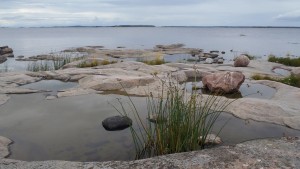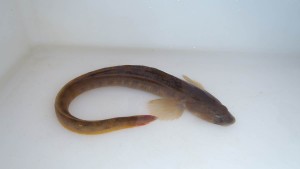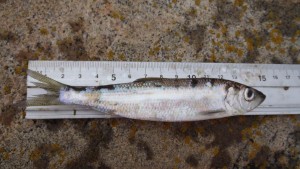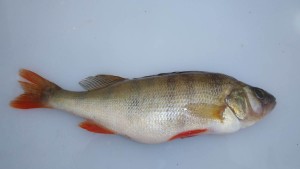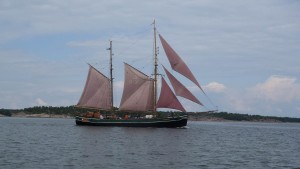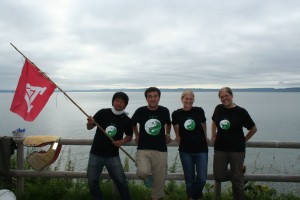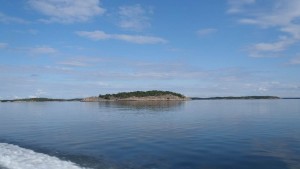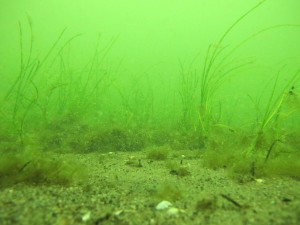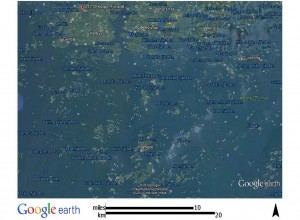Winged Grazers Mow Down Eelgrass in San Francisco Bay
By Pamela Reynolds (ZEN Coordinator)
Here at ZEN, when we use the word “grazer” we typically mean the small crustacean and gastropod invertebrates that live on and eat the algae (and sometimes the eelgrass) at our estuarine field sites. But for our partners at the Romberg Tiburon Center For Environmental Studies in California, grazers come with webbed feet, a hiss and a honk.
In San Francisco Bay migrating Canada geese mow down eelgrass beds and may help drive the persistence of separate perennial and annual growth forms within the same bed, says laboratory technician Stephanie Kiriakopolos who studied Zostera marina life history traits for her master’s thesis under ZEN partner Dr. Kathy Boyer at San Francisco State University.
Want to see the geese in action? Check out this video from Stephanie, and the nifty cages the San Francisco ZEN team constructed to keep these winged grazers out of our experiments.
Science is Creative
by Pamela Reynolds, ZEN Coordinator
Coordinating the ZEN is awesome. Not only do I have the opportunity to interact with incredibly smart and wonderful researchers across the globe, but I am constantly impressed with their creativity and talent. From writing marine ecological haikus to crafting algae and sea creature art, the ZEN partners continue to surprise me.
Here’s a video recently sent to me by Eduardo Infantes, a postdoc with Per Moksnes’ who assisted with the ZEN projects this past summer in Sweden. This video produced by Eduardo shows how the Swedish team used the experimental protocols and materials we sent them from VIMS to implement an experiment testing for predator effects in eelgrass beds at their field site in Gullmar Fjord. The video features Drs. Moksnes, Johan Eklov and Lars Gamfeldt, and grad student Jonas Thormar at the Kristineberg Marine Station on the west coast of Sweden. Just think how much shorter and more exciting scientific papers could be if they all included links to online video methods with fun soundtracks like this!
I’ll let Eduardo and some of the other ZEN scientists tell you in more detail about the experiment (affectionately called the “Podsicle” approach) in another blog post. Until then, enjoy the movie!
North and South Unite! A 4-day epic adventure across Japan
by Nicole Kollars and Rachel Gittman (ZEN graduate student fellows)
With the lab processing finished in Akkeshi (see Rachel’s blog “Sayonara Hiroshima”) we said goodbye to our ZEN colleagues and began a whirlwind sight-seeing adventure of the Japanese countryside. We must confess that we were a little intimidated at first. We relied so much on our new friends to translate for us and explain Japanese customs that venturing out on our own to explore the country was a little scary. Equipped with a pocket dictionary, a few maps, and a Japanese rail pass we boarded the train at the Akkeshi station excited and full of anticipation for the sights and sounds that were ahead of us.
First-stop: Sapporo!
After a 5-hour train ride across the beautiful, green hillsides of Hokkaido, we made our first stop in Sapporo. Sapporo is the largest city on Hokkaido and is most famous for its breweries. That night we stopped at the Sapporo Beer Factory for a lovely feast of fresh lamb and vegetables that were brought out raw for us to cook over a heated grill right at the table. We enjoyed the delicious food and beverages while talking about our research, life as a graduate student, and our plans for the upcoming semester.
The next morning we toured the botanical gardens of Hokkaido University. It was a little late in the season to see the flowers in bloom, but the pathways through the woods were beautiful. However, we quickly learned that Rachel’s injured ankle was not up for the task. A few days before, Massa-san had taken us to the intertidal to show us the different types of eelgrass found in Akkeshi Bay. Rachel had twisted her ankle in the rocks and the squeezing of the waders we were wearing had only intensified the injury. We decided that the ankle definitely needed some doctoring before we continued our walking explorations, which was an adventure in itself. It took some trial and error in communication while asking for directions, but we finally made it to a drug store to buy wraps and bandages. Rachel looked forward to the upcoming train ride to rest.
A “Harry Potter” train ride
We were fortunate enough to have the opportunity for an experience that not many tourists enjoy – the 22-hour Twilight Express train ride from Sapporo to Kyoto. This train travels along the Sea of Japan down the entire coastline of the main island of Honshu. It was very difficult to get tickets for this train. It is popular among the Japanese during their vacation time and Hori-san had to be very insistent during a conversation with the booking agent to ensure we had reservations. We are so grateful for his effort! The coastline was spectacular, especially as the sun began to set. Our eyes were glued to the window as the train reached the more southern towns and villages. We had excellent accommodations for the journey in a shared compartment with room for 4 people. We shared the room with an older man who did not speak much English but was very kind and insisted that we see the “Golden Pavilion” when we stopped in Kyoto.
Temples, Bamboo, and Geisha
Kyoto is known as the cultural capital of Japan. We only had 20 hours to see as much of the city as possible and we did not waste a minute of it. After settling into our youth hostel and grabbing a quick lunch at the “ZEN Café” (!), we put on our sunscreen, grabbed our fans, and began walking through the city. The receptionist at the hostel mapped out a touring path for us and we were not disappointed. Our journey took us through a maze of temples, shrines, gardens and shops. In the evening, we ended up in the Geisha district of Gion and saw a Geisha cultural performance at a local theater. The show involved a traditional tea ceremony, harp-playing, dancing, and short plays. Dark had fallen while we were in the theater, and we walked out onto cobblestone streets lit by paper lanterns. After dinner in downtown Kyoto we made our way back to the hotel to ice our ankles swollen from a day of walking. Nicole also had an injured ankle from a sprain involving a slippery staircase a few weeks before.
The next morning we boarded the train for the western part of the city. There we explored a ZEN temple and garden that included a long grove of bamboo. The dense canopy of bamboo was magical and a highlight of our Kyoto experience! From there we ventured to the Golden Pavilion as recommended by our friend on the train. It was well worth the long walk from the train station, the temple was so dramatic in its intensity. After bowls of ramen noodles (these noodles were definitely not your typical college student’s ramen) and green-tea flavored soft serve ice cream, we caught the bullet train to Tokyo.
Our last 24 hours in Japan
With the speed of the bullet train we made it to Tokyo in just over three hours and just in time for rush hour. Our connecting train from Tokyo to Narita (where we would be staying for the night and where the airport was) was packed face-to-face. It took us nearly 2 hours of wading through a dense sea of people with gigantic luggage bags before we reached this outskirt of Tokyo. Exhausted, we both agreed to pay for a taxi to take us from the train station in Narita to our ryokan for the night. A ryokan is a hotel of traditional Japanese style and we slept on futons in a tatami matted room. Across from the ryokan was a beautiful suite of temples, shrines, and gardens – perfect for exploring the next morning before we had to leave the airport.
We arrived at the airport with 6 hours to spare. We wandered around the airport shops, had our last lunch in Japan, and re-pack our luggage to shove in all the extra souvenirs we were bringing back to our families and friends. Finally, it was time to go our separate ways – Rachel to San Francisco and Nicole to Los Angeles to catch connecting flights to our homes in North and South Carolina respectively. Grateful for the journey through Japan together and the friendship forged, we knew we would see each other again soon – whether it be at conferences, while visiting each other’s laboratories, or in another eelgrass bed.
Check out some more images from Nicole and Rachel’s last few days in Japan:
Exploring Finland’s Outer Islands
by Paul Richardson (VIMS technician)
If you’re ever in the Archipelago Sea of Finland, then you must visit the outer exotic islands. I took advantage of a few slow days before the experimental breakdown to take an overnight trip to Utö Island on one of the free boats that make regular rounds of these islands. Utö is an island on the outer archipelago with a town, a light house and an old military base that was used in battles with the Russians and others.
The boat I took, the M/S Eivor, is a refurbished Norwegian fishing vessel that is very sea worthy. It has a nice cafeteria, inside benches and seats and, my favorite part, the open air upper deck that is three stories above the water with diner style benches and tables.
The boat passed and stops at many islands along its five hour trip. It is nice to see all of the islands, but if you get off of the boat, you will be left until the next day. So, it’s good to bring an overnight bag for this trip and it’s also preferable to contact people ahead of time at whichever island you choose. I contacted Hanna Kovanen at Utö Island. She, like most everyone else that I met in Scandinavia, speaks fluent English. She’s very nice, and she’s a native of the island. When she was younger she went to California for a foreign exchange program. Hanna is a very bright multi-tasker in that she served as my tour guide, hotel clerk, and chamber of commerce minister once on the Island. The tour of the lighthouse was 6 Euros and my room was 25 Euros. As I said, the boat ride is free so this is a very inexpensive trip. Who said Scandinavia is too expensive to visit?
While on the boat I made some new friends, Antti and Tuula Karlin. Antti is an orninthologist and Tuula is a school teacher. They are native Finns. Antti was very surprised to meet an American and, like some others in Finland, he referred to me as “exotic”! Overall, my experience was that most Finnish people who speak English love to talk to Americans (like me!) and they’re all extremely kind. The Karlins were no exception and I genuinely enjoyed chatting visiting with them. We exchanged emails and we’ve been trading pictures and information ever since.
One interesting fact about Tuula is that she “collects” swimming holes. She goes swimming all over Scandinavia and other places, despite the temperature. She keeps a swimming journal with her collection of sites. When I saw her on the boat ride back on the next day she informed me that she went swimming at Utö. Meanwhile, I was wondering whether my sweater, long johns, hat, and jacket, were enough clothes for the frigid air temperature! Boy, I’m such a wimp when it comes to cold water!
Utö Island
I spent the night on Utö Island. It’s one of the outer most islands of the archipelago. It has a very rugged beauty and is steeped in a rich history. On the island there is an old military base, some weather stations, fishing shacks, plenty of beautiful vistas, a 19th century lighthouse and lots of history. The lighthouse that stands there now was built in 1814 – the original light house built in 1753 was blown up in the Finnish war. The island even has its own endemic toad. What they don’t have are ticks. Nice!
Connection to the United States
On Christmas Eve in 1947 a United States ship, the SS Park Victory, was just off of the Utö lighthouse trying to maintain its position in the icy waters when its boiler exploded and blew a hole through the side of the ship sinking it. Ten of the 148 men died and the other 138 were rescued by the people of Utö. They took them into their homes and gave them shelter and food. This was recognized by the U.S. government on at least two separate occasions and the letters are framed on the wall of the chapel in the lighthouse.
According to Hanna, this was the first time that the people of Utö ever saw a black person. According to personal accounts that Hannna referenced in her tour, there was some confusion among the black sailors when they entered the houses and found that there were no segregated tables where they could sit. This also created confusion for the citizens of Utö! Needless to say, all of the survivors were seated at the same tables. Hanna also indicated that she is related to one of these black survivors.
Off to Stockholm
The next day I got on the much larger (cruise ship size) M/S Isabella, which is a Viking Line “ferry” that carries some cars and mostly pedestrians from Turku to several ports at various locations within the 10 nations that border the Baltic Sea. My boat was headed to Stockholm, Sweden. It’s a pretty sweet deal, really. I paid 70 Euros for a round trip ticket. The ship picked me up at 8pm on Monday night in Turku. Once on board, I dropped my bag off in my cabin which was very nice with a private bathroom and fresh sheets. I then checked out the restaurants, casinos, discos, and the huge mall-like tax free shopping center, and then I went to bed. I’d walked all over Turku all day and so I was quite tired.
I awoke at 7am when the ship was approaching Stockholm. It amazed me how close the ferry went to the rocky shoreline. At several points, I could have easily tossed a baseball onto someone’s summer cottage. The ferry docked shortly thereafter and I had the whole day to explore Stockholm and I didn’t have to be back to the boat until 8pm. I walked all over the city. I inquired about the buses and trains and water taxis, but I chose to see a city on foot. Taking it slow allowed me to really see lots of cool details that I would have missed on the bus.
Stockholm is a very old, very beautiful capital city of 870,000, located on 14 islands in the south east of Sweden. The first thing that I noticed was the beauty. The second thing that I noticed was that there were literally more bikes than cars. There were so many of them flying down the hill as I walked into the old town, that I actually felt safer crossing the automobile road with its crossing lights than I did crossing the bike lanes! But I think it’s great! In the States, it’s the opposite. We have the tyranny of the automobile and good luck if you commute by bicycle.
I don’t have the data here to back it up but qualitatively, I’m sure that the Finnish and the Swedes are more physically fit than my fellow Virginian Americans thanks in part to the higher prevalence of bicycle usage. I didn’t drive a car for my entire 40 days in Scandinavia and instead rode a bike or walked, which is probably the reason that I lost 10 pounds during the trip. It was high school the last time I weighed so little!
The city was lovely and the main activity that I did while there, aside from eating and walking, was my visit to the Vasa museum. The Vasa is a one of a kind attraction. In 1628, the king of Sweden, Gustavus Adolphus, in his haste, launched the state of the art warship, Vasa to send to Poland to fight in some Catholic Protestant battles. At 226 ft long and 172 ft tall with 36 guns (twice the recommended amount) and fatefully, not enough ballast, the top heavy vessel floundered and sank near her railway on her maiden voyage. In the absence of ship worms and the presence of anoxic conditions resulting from the pollution in the harbor, the ship was nearly perfectly preserved.
In 1961 archeologists knew that the Vasa laid somewhere in the harbor and so they started taking cores of the sediment to see if they could get a plug of some white oak which is the wood that the Vasa was made of. After many attempts, they finally located and excavated her. Using SCUBA and some type of fire hose pump they insert several harnesses under the hull and ultimately hoisted the behemoth, nearly intact, to the surface. They’ve been restoring her ever sense.
The thoroughness of the museum was simply mind boggling. I spent three hours there and I could only scratch the surface. It is six stories from the keel to the top deck. They had to replace all of the water in the wood with polyethylene glycol. There were skeletons of the people who were on board and perished in the disaster. There were models, and maps and MRIs of the hull. In some ways it almost resembled a modern ship yard with lifts and heavy equipment and restorers flitting around working. There were so many exhibits with artifacts that it was overwhelming. By 1pm I was quite hungry and I needed to see sunlight again. I had intended to get some food and return, but when I went outside it was so beautiful that I vowed not to go into any more museums! I spent the rest of my day in Stockholm sightseeing and taking tons of pictures. Towards the latter part of the day, close to the time when I would catch the ferry, I went from pub to pub trying various delicious food and beverages.
As I got on the ferry in Stockholm on Tuesday night I received a phone call from Christoffer. He wanted to warn me that I must come directly to the lab and prepare for the field on Wednesday as soon as I got back from Turku. We would go to the field that afternoon and begin the ZEN breakdown since there was very bad weather predicted for Friday. My mini-vacation was over and it was time to get back to work on this last phase of my involvement with the ZEN project in Finland.
A Dissertation Defense, Finish Style
by Paul Richardson (VIMS technician)
After many years of graduate school, students are expected to defend all of the work they’ve done before they receive their degree. Doctoral defenses in the States are pretty intense and generally consist of a public lecture followed by public and private questioning session that can last for hours. I’d been told that European defenses can be much more elaborate and so, when I heard that one was scheduled for a Finnish student here at Åbo Akedemi I decided that I must go! Camilla, a graduate student here helping with the ZEN work, invited me with the instructions to bring my dress pants and dancing shoes. And my new Swedish language skills as the defense would not be in English. So, I woke up early and rode my borrowed bike in my dress pants with my backpack the 10 km to the little town on Korpo Island to catch the bus for the two hour ride to Åbo Akedemi’s Bio City in Turku.
Once I got to Turku I went to the Domis, which is Åbo Akademi University’s housing for guests. The Domis is a very Spartan grey concrete institutional building with more locks that Fort Knox (a military base in the USA). Once I penetrated the outer perimeter I met the very friendly Anita Bruman Tott who checked me in. One of the first things I recall her asking me was, “hey, are you the TV guy?” I guess my cameo on the Finnish TV talking about seagrasses has made me slightly famous here!
The fee for staying at the Domis was quite reasonable at 30€. It turns out the room was just as Spartan as the rest of the building and the bathroom was a little cramped, but the bed was very comfortable, the view was pleasant, and later that night, I slept like a baby.
Since the defense was a formal affair, I recognized that I was grossly underprepared in the wardrobe department The only suit I’d brought with me was my wetsuit and, despite the fact that we are marine ecologists, showing up to the defense salty and smelly probably wasn’t the best way to go, even if it would have been funny (and uncomfortably hot!). Christoffer let me raid his closet and I came up with a tie and a slightly too small sport jacket. In need of a dress shirt, after checking into Domis I went straight to the mall. The salesman had a good laugh when I came out of the dressing room with the brand new shirt on (with all of the tags still attached) under the tie and sport coat. He cut the tags and rang me up.
All dressed up I headed downtown toward Bio city, grabbing a snack along the way as I had been warned that the defense would take several hours. Realizing that the defense would be starting soon, I picked up the pace. Camilla called me and, after asking where I was, told me to quickly get on a bus as I wouldn’t make it in time. They are very punctual here in Finland and if I was even a minute late I risked being locked out of the “proceedings!” So, I backtracked quickly to a bus stop and crossed my fingers that the first bus I hopped on was the most direct one to the university.
Thank goodness for the effective mass transit of Turku! , I made it just in time. The door closed right as I sat down. Right away, three well groomed gentlemen walked inside wearing very nice suits – one even had a top hat! Everyone in the auditorium stood. We stayed standing until someone gave a signal to sit and everyone sat in unison. I started to wonder – is this a dissertation defense or a court of law? Cameras started clicking away, preserving this momentous occasion, and so I went to get mine. That’s when I realized that I’d left it on the bus! That was bummer. Luckily Camilla had a camera and shared her photos with me.
Before I forget, the student defending his defense was Matias Scheinin. His advisor, Johanna Mattila, was wearing the top hat. The third gentleman was the “challenger,” an external reviewer flown in to test the student’s knowledge, from Sweden, Peter Eklöv.
After introductions, Matias launched into the formal hour-long presentation of his work on the “Patterns and processes of littoral zooplankton composition in relation to the trophic state of the environment.” The defense was in Swedish, but luckily for me, the presentation slides were in English. His work on the zooplankton ecology of the Baltic was very interesting. One of his experiments involved natural mesocosms, which consisted of coves in islands (called flads) that had varying communities with varying levels of predation by different fishes including roach (Rutilus rutilus) and perch (Perca fluviatilis). The take home message from that experiment for me was that differences in vegetation (presence or absence of submerged aquatic vegetation) affected the feeding rates of perch, but did not affect roach feeding. I’d seen a lot of roach around the docks at the field station, so it was very interesting to learn more about their ecology.
After the formal presentation the challenger, Peter Eklöv, critiqued Matias’ dissertation for the next two and half hours in front of the entire audience! This was very different from the defenses I’d seen back in the States where the professors grill the student in a closed door session after the public presentation. All of the interrogation was in Swedish, so it was difficult for me to follow. Eventually the whole thing was adjourned and we went to begin the celebrations – Matias had passed the exam and was now going to be a PhD!
In close vicinity to the auditorium the toasts began. In English we say cheers, but in Swedish they say skål (pronounced skole or skull). Then everyone dispersed and met back at the reception hall a few hours later. At the reception there was another toast outside in the lavish entry lobby and then, once again, the well-dressed crowd walked in and stood behind their chairs until given the signal to sit and the toasts resumed. Then there was an introduction to the buffet menu, which included rostad sik med pepparratssmörsås och honungsrostad rödbeta (roasted whitefish with peppercorns and honey roasted beetroot) for the main course and a wonderful äppelpaj med kardemummås (apple pie with cardamom) for dessert. Dessert was served with a selection of Scotch whiskies and cognacs and coffee, plus many more toasts, roasts, skits and power point presentations. Matias experienced a thorough hazing, all in good humor of course.
After dinner Matias’ brother-in-law and his all physician rock band played many great tunes ranging from the Rolling Stones, to Parliament, to Alanis Morrissette interspersed with very good Finnish rock songs (I couldn’t understand the words but they totally rocked!). Ultimately things wound down around 1:30 AM . While the others headed off to the “after-party” celebrations, I carried my old bones back to my Domis room to sleep.
Sayonara Hiroshima, Konnichiwa Akkeshi
by Rachel Gittman (ZEN graduate fellow)
After nearly a month in Hiroshima, it was almost time for me to make my way to Akkeshi to help Dr. Nakaoka and Nicole Kollars, the other ZEN graduate fellow in Japan, process samples post-breakdown of the ZEN main experiment. The experiment tests the interacting effects of mesograzers and nutrients on seagrass ecosystem function through the use of a grazer deterrent rather than traditional caging techniques. Before I left Hiroshima we had one more experiment to run testing the roles of predators in local eelgrass beds, and then I was off to Tokyo for a few days with Hori-san.
Conducting assays to test the strength of predation by small fishes and crustaceans on mesograzers at our field site was a fairly straightforward process, but was particularly challenging when the tide was up and the current strong. We experienced both of these conditions during our last predation assay. The water was too deep for setting up the assay by snorkel, so Hori-san and Hamaoka-san completed the assay with SCUBA. Shimbukoro-san and I used snorkels to set and collect minnow traps, which provide data on the abundance and composition of the ambient predator community. We caught several small fish in each of the minnow traps, primarily gobies and rockfish, but we decided to conduct additional fish sampling using a modified seine to get a better representation of the fish diversity at this site.
On my last day in Hiroshima, the lab surprised me with a Yukata, a summer time kimono and a farewell dinner. The next morning as Dr. Hori and I headed to the airport, I grappled with the realization that my time in Hiroshima was ending. This was not an experience I was likely to forget, but I knew that I would genuinely miss my new friends.
Finding my way in Tokyo
Before heading to Akkeshi to help Dr. Nakaoka with the ZEN experiment’s at the northern Japan site, I spent a few days in Tokyo. Tokyo is overwhelming to say the least; just stepping off the train into Tokyo Station makes you realize how large and bustling of a city it really is. You could spend an entire day just in the train station with all of the shops and restaurants, but fortunately I had time to make it out of the station and see two of the major tourist attractions in Tokyo: the Imperial Palace and Ueno Park.
Although you can only enter the palace two times of the year (new Year’s day and the Emperor’s birthday) without a scheduled tour, just seeing the outside of the palace was worth the walk in the hot August sun. Ueno Park is a large park in central Tokyo that includes numerous museums, temples, shrines, and a zoo. Although I didn’t have time to see it all, I enjoyed the exhibits in the Tokyo National Museum and visiting the shrines and temples throughout the park.
Akkeshi: a different climate
From Tokyo I headed north to the town of Akkeshi where I would spend the next week assisting with the ZEN research. Compared to the fast pace of Tokyo, Akkeshi is like a different world. Akkeshi is a small, quiet fishing town on the Pacific coast of Hokkaido, the northernmost island of Japan. The marine lab where the northern Japan ZEN team was based is located just outside of Akkeshi, within a National Park.

ZEN graduate student exchange fellows Nicole Kollars and Rachel Gittman marvel at how tall the eelgrass is in Japan
After a warm welcome from Dr. Nakaoka, his wife, the lab and a minor earthquake (although it didn’t feel so minor to me), I jumped into sample processing. The fieldwork for the main experiment (see Nicole’s blog) was complete, but we had a lot of samples to process in a very short time. Although I had processed samples for ZEN in North Carolina before, sample processing in Akkeshi was a little different. Simply put, everything is just bigger in Akkeshi. The seagrass is bigger, the grazers are bigger, and, naturally, the epiphytes are bigger. Filtering the epibionta scraped from the eelgrass shoots was a challenge because of the large scale of all of the organisms.
Fortunately, because of the dedication of the lab, we were able to complete sample processing in the week that I was there and I still had time to hike to the top of the cape above the lab with Nicole and witness to breathtaking sunsets. We also made sure to sample some of the delicious ice cream made fresh from a local dairy just outside of town.
Before I knew it, it was time to leave Akkeshi, but not before we spent our last night eating sushi and celebrating with the lab at a wonderful local restaurant. Although my trip was not quite over, this was my last day working with the ZEN team in northern Japan. I truly enjoyed the experience and learned a great deal from our Japanese collaborators. Hands-on experience conducting multiple field experiments in entirely different environments (North Carolina, Hiroshima, and Akkeshi) was eye-opening for me and gave me a new perspective on collaborative research. I have tremendous respect for the ZEN partners all over the world trying to make this project a success in their own unique environments.
I’ll end the blog here, but see my and Nicole’s final joint-blog for the highlights from our travels in the land of the rising sun.
Embracing local language, food and traditions in Finland
by Paul Richardson (VIMS technician)
Language and Culture
Before arriving, I didn’t realize that 75% of the people here speak Swedish and not Finnish. I’ve heard it can be a problem for kids who don’t learn Finnish when they go to find work in the city. One thing that is lucky for me is that most everyone speaks English. However, I usually have to warn people or they will assume that I speak Swedish. Apparently my Scandinavian heritage lets me blend in well here in Finland. Anyhow, I’m learning a few basic phrases and I even conducted an entire transaction at the grocery store the other day without speaking any English! Gå Svenska! (Go Swedish!)
A common language – food
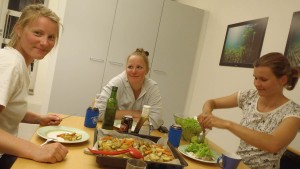
After a hard day of fieldwork, Paul relaxes by cooking a delicious meal with the graduate students working on the ZEN project in Finland
I’ve been able to practice my Swedish and Finnish both when visiting the home of the Boströms, my wonderful hosts here in Finland. Three times now the Boström’s have invited me to their lovely country home for some of the most amazing meals! The first one involved a “pastry” with chanterelles. I would equate it to a much enhanced quiche. It was amazing. I should also mention that they always also have an amazing assortment of cheeses, meats, olives and crackers as hour’s devours regardless of the main course. Talk about host hospitality!
Then the other night, in a pure Norwegian tradition, we smoked some perch and white fish in the most amazing way. Chris has a smoking box that he put aspen wood chips and sugar cubes into the bottom of. I brought some gutted and salted fishes that we put into the box on a grate over the wood chips. Then Chris put juniper sprigs on top. Then he put the smoking box onto a wood fire for about 40 minutes. The result was amazing. You then take a fish and break it in half, revealing the entire skeleton which is then easily removed. With it they served a crunchy brown bread that we put butter, the fish and then sprigs of dill onto. This was served with beer and Norwegian anise liquor that was simply to die for. I had visions of Vikings as these delicacies melted in my mouth on their lovely patio.
After every meal, the Boström’s always have some wonderful dessert. With the fish it was a humungous and delicious blueberry pie a la mode, and after the chanterelle pastry it was just the ice cream but it had Finnish chocolate shavings and they made on the spot a sweet sauce with fresh raspberries, blueberries, and (I never would have guessed it) basil! Oh my goodness! I never realized before coming to Finland what wonderful culinary treats I would be in for.
Embracing local traditions – the polar bear plunge

Paul’s face right after he came up from his first “polar bear” style plunge into the frigid Baltic Sea without a wetsuit!
One Saturday while on a nice bicycle that Minna and Christoffer’s friend loaned to me, I got a flat tire about 10 km from my home base at the lab in Korpoström. I walked back and so I was pretty tired and ready for a beverage when I quickly checked my email first. Out of the blue Christoffer had emailed me to tell me that my trip to Finland would not be complete without doing two things: first, jump into the Baltic (without a wetsuit) and next go sit in a sauna, with a few beverages in between. It was such a niec day I thought, what the heck! I did 4 cycles of this. I think they call it a polar bear plunge or something like that back home. Wow, 16oC water will really remind you that you’re alive! I won’t say it was nice, but it certainly was invigorating! Marie later told me that many of the locals do it in the dead of winter by cutting a hole in the ice. I think I might be a little too wimpy for that. But, give me a drysuit and some mesograzers to catch and I’m your man.
The Natural Beauty of the Archipelago Sea
by Paul Richardson (VIMS technician)
ZEN-like surroundings in the Archipelago Sea
The Archipelago Sea is like no other place that I’ve ever been. It’s completely different from the Spartina mud flats and warm eutrophic waters that I’m used to in Virginia. The glacier scoured bedrock islands go on forever. They are mostly granite with a variety of low vegetation and trees. The trees are usually small, some approaching bonsai status. I’ve seen fully mature miniature pine trees growing in a very limited amount of soil that collected between a few rocks. Also stunting them are the arctic winds and sea spray that blast them incessantly.
On the outer islands trees are absent altogether. But, these short sometimes bonsai trees and the lichen encrusted bedrocks remind me of what we have in the Appalachian Mountains but instead of being at 900 meters elevation, it’s all essentially at sea level. Unlike the small muddy islands of the coastal plain in the lower Chesapeake Bay, these rocky islands were created by glaciers and they’re are all rising due to the rebound of the land after the glaciers retreated. The average rebound is about 8mm per year! At this rate, sea level rise will not submerge these islands. In fact the curator of a local museum told me that he knows people who are frustrated with places where once viable waterways are now fields. We have the opposite problem in the Chesapeake region, where the islands are sinking and ultimately disappearing. The islands of the Baltic also hold many surprises in the form of Japanese ZEN water features. You can never create a more beautiful water feature than can nature.
More Baltic to Chesapeake Comparisons
To better visualize the extent of the Baltic I like to compare it to the estuary that I know so very well, The Chesapeake Bay. The Baltic is a much larger estuary. It is over 5 times as long at 1600 km whereas the Chesapeake is 300 km. The Baltic has an average depth of 55m whereas the Chesapeake has an average depth of 14m. The area of the Baltic, at 377000 km2 is over 30 times that of the area of the Chesapeake at 11601 km2. But most striking to me is the difference in the salinities between these two bodies of water. Having a relatively broad mouth and a shallow basin the Chesapeake has a much higher salinity of about 20 psu in the lower portions, whereas the Baltic with its narrow strait has a much lower salinity of 6 – 8 psu. However, in the deeper holes in the Baltic, there are super stratified salty “basins” that are anoxic and harbor huge sulfur communities.
So even though both systems have Zostera marina and the epifaunal grazers are similar, there are vast differences in much of the fauna between the two estuaries. The Chesapeake with its extreme temperature variation, wide open mouth, and saltier water has many more transient marine fishes that change with the seasons. The Baltic is more of a closed system with salmon, pikes, cyprinids, and perches (see the pictures to the left of some of the fish I caught at the ZEN site here in Finland). Similarly, however, in the eelgrass beds, both estuaries have gobies, pipe fish, sticklebacks and blennies.
Pack Ice
In contrast with the Chesapeake, here in the Baltic researchers have to contend with pack ice, which forms in November and lasts until early spring. Christoffer told me that every five or so years the ice freezes so thick that ice experts assess and plow it and make designated official roads to accommodate the transport of supplies such as building materials to islands in a way that is much more efficient than by boat (think Ice Truckers). I’ve seen ice on the Chesapeake, but it has never been thick enough to drive a truck on, much less walk on! Chris also said that if it’s calm and it doesn’t snow, then some of the most amazing ice skating conditions will occur. Too bad I head home before the cold weather sets in.
Traditional Wooden boats
During the summer time, however, boats are still the most common means of transport among the islands. I’ve noticed that in addition to the more commercial ferries, there are a lot of traditional wooden boats in the Archipelago Sea. It’s an art that has returned in recent years. Many people are restoring the old wooden boats, including Christoffer! He has several including a 7 meter Swedish racing boat that he restored and maintains. He purchased it when he was a graduate student so that he and his wife Minna (who’s also a research scientist) could get away when they had a break from their studies. Purchasing an island on a graduate student income was out of the question so they got this lovely wooden boat.
The Changing Baltic Sea
Temperatures are dropping, we’re having more storms, days are getting shorter, and fall is almost here. Summer, it seems, was over in a day. There will be more posts on the sporty conditions that we’re beginning to experience and will be experiencing more often with the changes in the seasons. To be continued as ZEN 2012 in Finland marches on!
Meditating on ZEN
by Nicole Kollars (ZEN graduate research fellow)
As my time with the ZEN team in Japan draws to a close, I am beginning to look back at what I have gained from this experience. Aside from being exposed to the dynamics of a temperate eelgrass ecosystem, I learned the ins-and-outs of subtidal field work. I collected samples for my own master’s thesis research and discovered new techniques that will be helpful for future projects. I experienced the daily life of someone who lives on the other side of the world and have mastered the use of chopsticks and the art of cooking rice. I met amazing people, saw amazing places.
All of this is wonderful, but what I am most grateful for is the experience of international collaborative science. It is really awesome to be a part of a project that brings together researchers from different countries, different cultural backgrounds, different life experiences, and different languages. Understanding the effects of nutrients, grazers and predators on the ecology of eelgrass beds provides the mission, but I think it is the universal characteristics of being a scientist (curiosity, passion, and hard work) that truly unites us. It has been an honor JN team!
(Wet)Suiting up for research
by Paul Richardson (VIMS lab technician)
The Experimental Site
Just barely over my jet lag, we recently set up the main ZEN experiment at the Fårö Island eelgrass meadow in about 3 -4 meters of water a one hour boat ride from the field station in Korpoström. Unlike the warm shallow waters of the Virginia grass beds, all of the work was done in SCUBA with dry suits by Camilla, Anna and Christoffer. I assisted from the boat or in my 7mm wetsuit with snorkel gear.
The plots were staked out with short galvanized rebar rods instead of the PVC poles that make up our “pole gardens” in Virginia. For marking tags they ingeniously employed cut squares of linoleum flooring tabs. The site perimeter is marked by small buoys. Because the water is so deep at the field site, there is no worrying that a small boat will run over the plots.
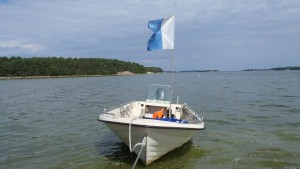
The research vessel used by the ZEN team in Finland. Note the blue and white dive flag. In the U.S.A., red and white flags are used to alert that divers in the water.
Witnessing the huge addition of logistical effort to conduct the ZEN work in deeper water with SCUBA and especially dry suits gives me a new appreciation for what the ZEN partners working at deeper subtidal sites have to do to get the job done. Everything takes at least twice as long. The work and general communication is more difficult. Work is limited by the air in the tanks, bottom time, and general fatigue. Once the work is done and everyone is out of their dry suits, they can’t just jump back in the water and fix something if needed. It usually takes another planned trip.
Algal Blooms!
Further complicating matters is the fact that the usually clear waters of the field site (see pictures from the 2011 experiment) have been clouded by a senescing blue green algae bloom that leaves the water full of chunks of a green, snot-like substance that you don’t want to swallow – apparently it is hazardous to your health. Also, the eelgrass beds are covered with a matrix of algae that are dominated by the frilly Ectocarpus. Otherwise, the eelgrass blades themselves are beautiful, green and covered with very few epiphytes. But these Ectocarpus mats are so thick that in places they go completely anoxic and turn white. We see similar effects during certain times of the year in Virginia where large blooms of the green algae Ulva and red Gracilaria drift in and smother the eelgrass in the Chesapeake. Here in Finland there is the danger that if you disturb these mats you can get a shot of hydrogen sulfide that can penetrate right through your skin.
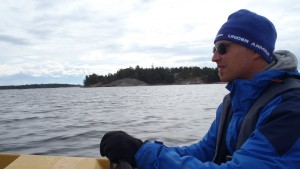
Christoffer Boström navigates the complicated seascape of the Archipelago Sea to the ZEN project site on Fårö Island, Finland.
Also, since the Fårö Island site is about 24 km away it requires an hour long boat ride. With fuel costing 1.63E/L (that’s $6,71/gal) and SCUBA setup and breakdown time, every field trip is a significantly greater investment of time and money than what I’m used to. Field days are usually 15 hour days. But once it’s all done I know it will all have been worth it.
According to the locals and everything that I’ve read, the Archipelago Sea has over 30000 islands! Being the experienced boat captain that I am back in the States, I can say that I won’t even attempt to navigate a boat around here. The gauntlet of islands on the way to the field site is mind boggling. I’ll leave the navigating and boat driving to Camilla, Marie, and Christoffer, who have the local knowledge and skills to safely transport us to and from the field site at Fårö Island.
Finnish News Media!
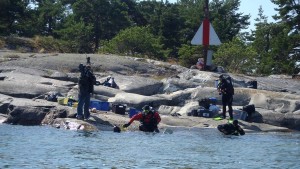
Journalists from the Finnish Nature channel film the ZEN team in Finland as they prepare to setup a large experiment
On top of everything else, we also had a visit from the Finnish news media. Christoffer brought them by boat to our remote field site shortly after the beginning of the work on the 13th. We were each interviewed for the national T.V. news, the radio, and the magazine, Suomen Luonto, which literally translated, means “Finnish Nature.”
It went pretty well, except that I gave the reporter some footage of us working in the grass beds of Virginia and I neglected to delete the audio which I didn’t think would be included, but it was. Also, in my jetlagged state, I mentioned that prior to the human perturbations in the Chesapeake Bay, “there was 90 % more (sea) grass in the Bay,” which, if taken out of context is not exactly correct. The seagrass coverage that we have now is 10% of historic levels. In other words, seagrass coverage in the Bay was historically 900% of current levels! Either way you look at it, that’s a huge and worrisome decline given all the important ecosystem services and functions that seagrasses provide. Media exposure can be good for your cause, but I’m finding it can also be difficult. Anyhow, overall, I think we got the message across that eelgrass meadows are important systems all over the northern hemisphere and that they need to be protected. Check out the ZENscience news page for a link to this story.

